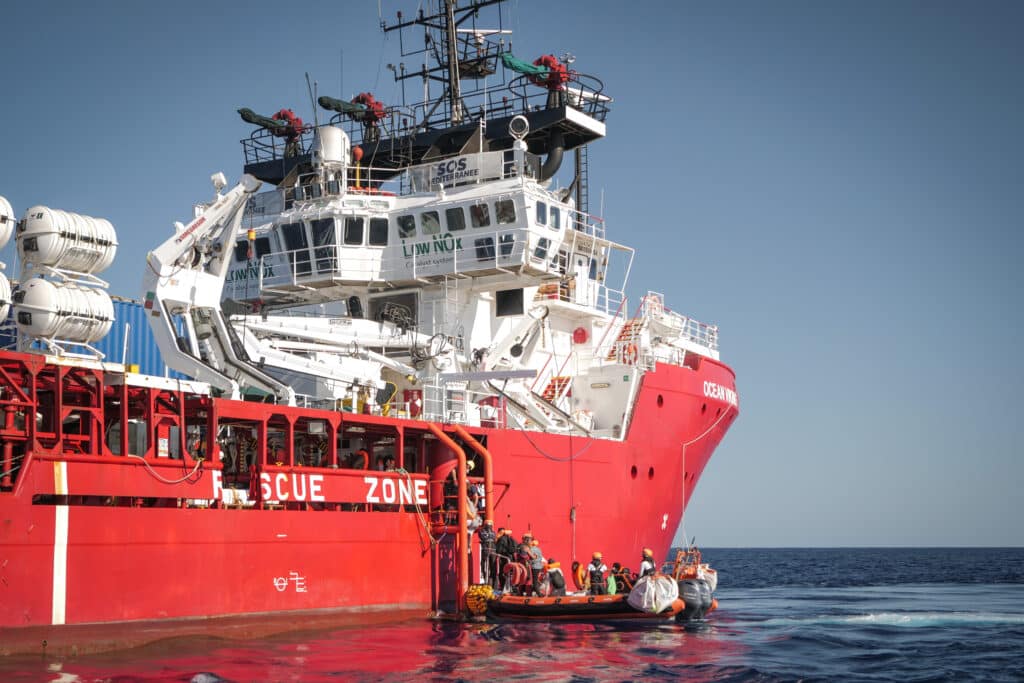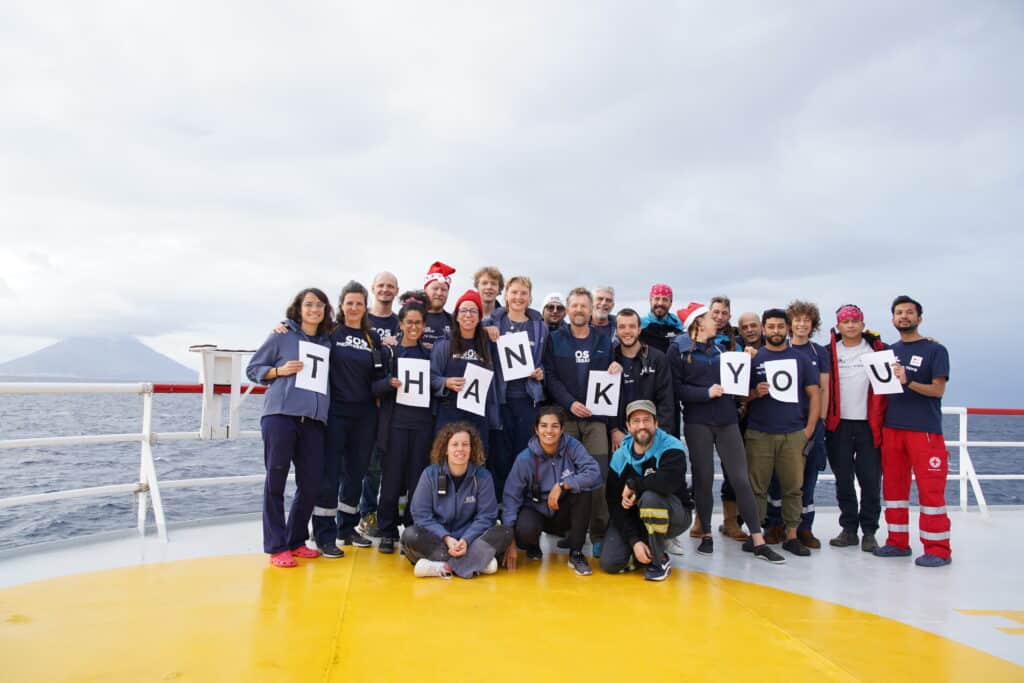
A Search and Rescue Mission to Save Lives
After the end of Mare Nostrum, a rescue operation launched by the Italian Government, and the subsequent EU disengagement from search and rescue operations in the area, 2014 faced a huge increase of deaths in the Mediterranean Sea. In 2015, a group of humanitarians and seafarers in Europe became astonished by the escalating humanitarian crisis at sea. Motivated to save the thousands of lives lost near European borders, the group formed as SOS MEDITERRANEE. Over time, a rescue team developed. The structure that has evolved has allowed for tens of thousands of lives to be saved.
The Ocean Viking, the current operating ship, has transformed into a space fully equipped to provide physical and psychological care. The ship now holds a built-in hospital, women and men’s shelter, and a room for children, all of which is meant to respond to the needs of the survivors. Since the Ocean Viking operates in international waters that span within the reaches of North Africa and Italy, the teams maintain contact with the relevant maritime Libyan and Italian authorities, as per international maritime law. Contact and coordination with these authorities is ensured during each rescue operation. However, not all is always smooth sailing. Since the beginning of 2023, Italian authorities have been granting them safety in ports further and further away from rescue areas in the central Mediterranean, typically in the north of Italy. As such, up to 10 days can be lost due to additional travel time away from rescue operation areas.
The organization’s mission is split into three parts: save, protect, bear witness. During a search and rescue operation, those on the ship use binoculars to search the horizons for boats in distress. Planes associated with non-profit organizations such as Pilotes Volontaires and Sea Watch are eyes in the sky. Once a boat is spotted, maritime authorities are informed of the rescue mission through the relevant Rescue Coordination Center (RCC) and speedboats are launched from the rescue ship. (You can find a record of the rescue operations here.) Once a position is secured, the boat in distress is stabilized, lifejackets are distributed, and those being rescued are reassured. Rescuers begin with women and children. 25% of people rescued are children, including 80% who are unaccompanied. All who are rescued are assured that everyone will be safe on the mothership; with the help of a translator. “Completing the rescue takes some time. It’s important to complete it calmly and reassuringly,” explained the International Development Director, Fyras Mawazini.
One of the priorities after completing a rescue mission is to then protect and care for the survivors on board. Firstly, survivors are informed of their rights and given back a sense of dignity. Food, water, and clothes are provided; medical checks are administered. When possible, survivors are offered a chance to let their families know they were rescued. Partners of the Italian Red Cross await the arrival of the ship for disembarkation. A rescue is completed once survivors disembark in a place of safety.
Bearing Witness
Bearing witness of the humanitarian crisis happening at sea is central to their mission, both to shed light on the situation in the Mediterranean and amplify the voices of those who are rescued. A majority of them are escaping disastrous situations, such as war, famine, or a loss of livelihood because of climate change. The Mediterranean Sea remains one of the world’s deadliest maritime routes, with countless lives lost each year due to dangerous crossings and harsh conditions. According to the International Organization for Migration (IOM), over 28,000 lives have been lost over the past decade, but it is probable that many more deaths remain undocumented.
Transparency is also a crucial element to raising awareness of the situation. All elements of the operation can be found on the website, from how rescues happen, to the personal accounts from people who are rescued. This commitment to transparency not only serves to inform the public but also holds significance at a legal level. The detailed documentation of each mission becomes a valuable resource, offering a clear record of events. This not only provides accountability but also ensures that no mistakes were made during the operations. By making such information readily accessible, the organization reinforces its dedication to accountability in its mission to address the ongoing humanitarian crisis at sea.
Other attempts to spread awareness are through educational activities and partnerships with cultural events and artists, who have produced films, graphic novels, books, and organized cultural events, all aimed at supporting the mission and raising awareness of the Mediterranean crisis. Several movies have been documenting the rescue operations.
Recently, the organization partnered with the French distributor of Me Captain, a film based on a true story, which was nominated for a Golden Globe award for the section of “Foreign Language Film” and represented Italy at the 2024 Oscars. This film, co-written with the survivors, centers around the lives of two young boys leaving Senegal with the hope of reaching Europe. It tells their challenging and compelling story of crossing different countries in Africa, including traversing the desert and the perilous Mediterranean Sea. Artistic interpretations, like Me Captain, can help reach a larger audience and spread awareness of the situation at hand, by offering a glimpse into the real-life struggles faced by individuals undertaking such perilous journeys.

The Future of Maritime Rescue
Over the years, SOS MEDITERRANEE has developed to what it is now. Thanks to its structure, thousands of rescue missions have been executed. In 2023 alone, 2,299 individuals were rescued by the Ocean Viking. Given how structured the organization is, it makes sense that the information they have learned could be applied elsewhere. “What we have done in the past eight years is acquire a huge know-how on mass rescue that is really technical. We can use our experience and the guidelines we have created to help develop other operations. We have witnessed many other tragedies so it’s important to share our experience and help address the crises in other high seas where people attempt to cross in search of a safe place,” expressed Mawazini.
From rescue operations, data is collected, documentation is made, and analyses of the means and needs in the central Mediterranean are done. Sharing data with other actors, such as the International Organization for Migration (IOM)’s Missing Migrants Project, is essential for situational analysis. All of the above helps SOS MEDITERRANEE advocate about the humanitarian crises at sea and the necessity to address the needs efficiently.

Partnering with Friends of Fondation de France
A mission as developed as SOS MEDITERRANEE’s can only run with the help of donations. When asked about potential challenges faced, the need to constantly raise funds was mentioned as the organization relies almost entirely on individual donations. With every donation, the organization is enabled to carry out operations, trainings, and educational initiatives. If you are interested in joining their public effort to rescue lives at sea, consider donating! “We are happy to partner with Friends of Fondation de France and have a chance to get the support of the American people,” voiced Mawazini. Beyond donations, their hope is that you can spread their message, the hope of their mission, and the testimonies of the lives they are saving. “Behind each person rescued, there is a personal story and journey, and hope for the future,” shared Mawazini, “We hope that you can share these stories of resilience and hope. Everyone deserves to be rescued at sea.”



